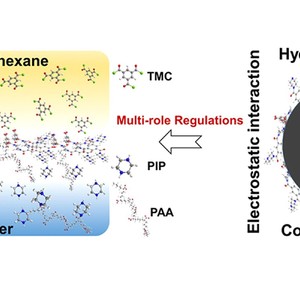Multirole Regulations of Interfacial Polymerization Using Poly(acrylic acid) for Nanofiltration Membrane Development
Citation
Jincheng Ding, Huiqing Wu*, and Peiyi Wu*. Multirole Regulations of Interfacial Polymerization Using Poly(Acrylic Acid) for Nanofiltration Membrane Development. ACS Appl. Mater. Interfaces 2021, 13, 53120-53130.
Abstract
Effective control of monomer diffusion and reaction rate is the key to achieving a controlled interfacial polymerization (IP) and a high-performance nanofiltration (NF) membrane. Herein, an integration of multirole regulations was synchronously realized using poly(acrylic acid) (PAA) as an active additive in a piperazine (PIP) aqueous phase. Thanks to synergistic interactions, including hydrogen bonding, electrostatic interaction, and covalent bonding between PAA and PIP molecules, together with the increased viscosity of the solution, PIP diffusion was rationally controlled. Moreover, interfacial polycondensation was also restrained via the modestly reduced pH of the aqueous solution. These contribute to the formation of a thinner, looser, more hydrophilic, and higher negatively charged PAA-decorated polyamide selective layer with a unique nanostrand–nodule morphology. The harvested NF-PAA/PIP membrane showed an ∼70% rise in water permeability (up to 23.5 L·m–2·h–1·bar–1) while retaining high Na2SO4 and dye rejections. Furthermore, the optimized NF-PAA/PIP membrane presented a superior fouling resistance capability for typical pollutants, as well as long-term stability during successive filtration. Thus, this work offers a straightforward and impactful approach to regulating IP and promoting NF membrane properties.


